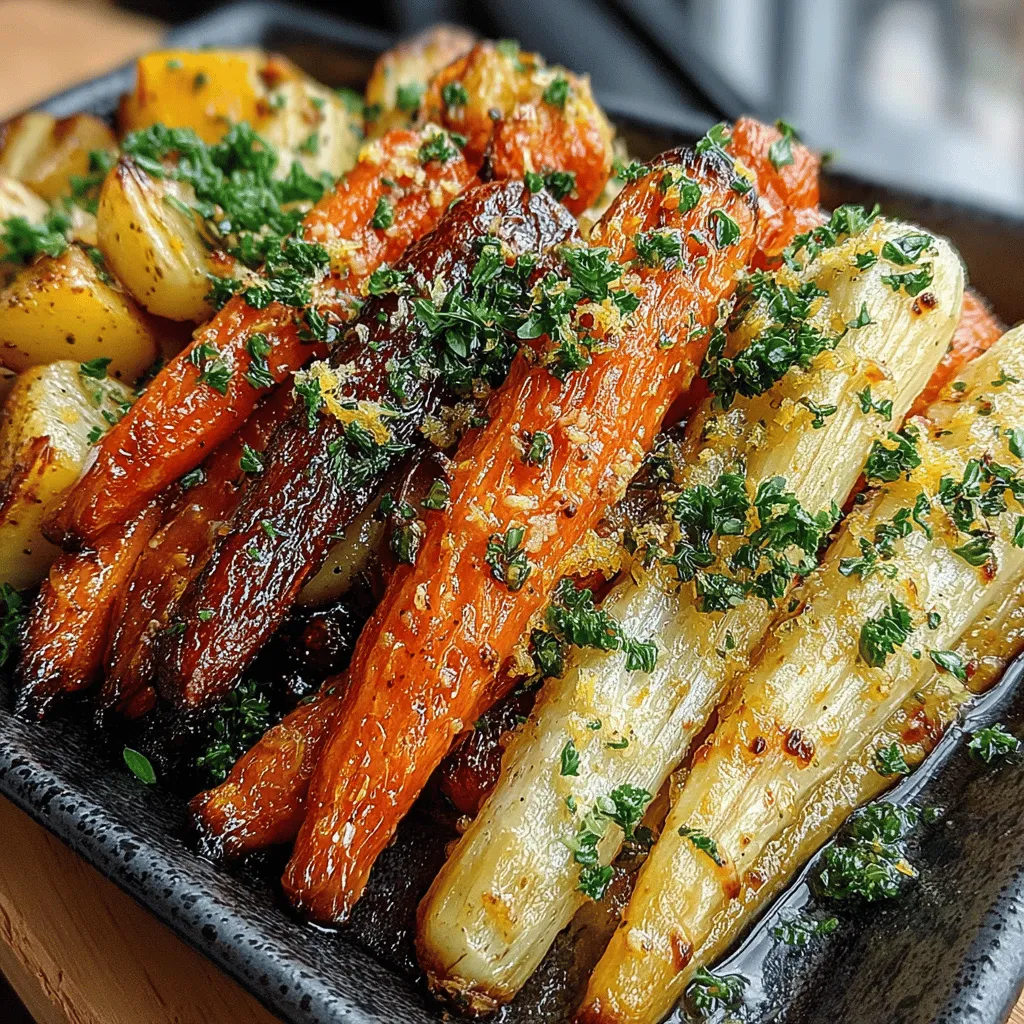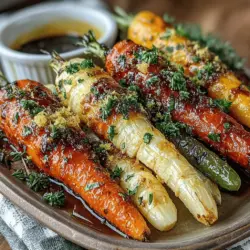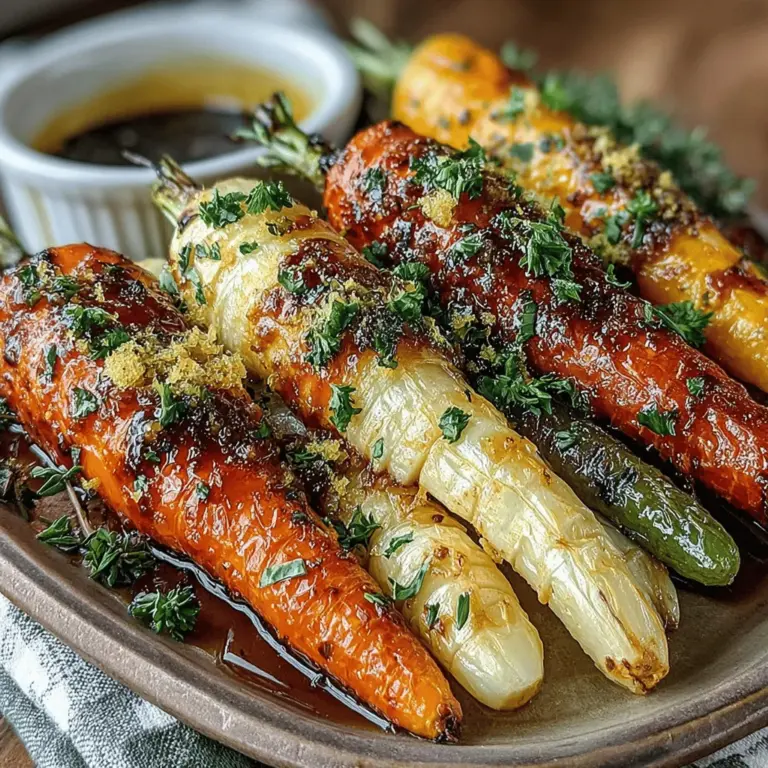Sweet Harmony: Maple Glazed Carrots and Parsnips
When it comes to comforting and flavorful side dishes, few recipes can rival the delightful combination of maple glazed carrots and parsnips. This dish encapsulates the essence of seasonal cooking, offering a vibrant, sweet, and savory experience that enhances any meal. The natural sweetness of the vegetables is beautifully complemented by the rich, earthy tones of maple syrup, making it a beloved choice for family gatherings, holiday feasts, or simply as a nutritious addition to your weekday dinner table.
Carrots and parsnips are versatile root vegetables found in a variety of cuisines around the world. Their adaptability makes them perfect for roasting, mashing, or even blending into soups. However, the sweet glaze created by maple syrup elevates these humble roots to a new level, creating a dish that is both comforting and sophisticated. Whether served alongside roasted meats or as part of a vegetarian spread, maple glazed carrots and parsnips are sure to please a crowd.
The Benefits of Carrots and Parsnips
Before diving into the recipe, it’s essential to highlight the nutritional benefits of the star ingredients: carrots and parsnips. Carrots are rich in vitamins such as A, C, and K, as well as essential minerals like potassium. The high beta-carotene content is particularly noteworthy, as this antioxidant converts to vitamin A in the body, playing a critical role in maintaining healthy vision, skin, and immune function. The fiber found in carrots aids in digestion and can contribute to a feeling of fullness, making them a staple in balanced diets.
Parsnips, often overlooked in favor of their orange counterpart, are equally nutritious. These creamy-white root vegetables are packed with vitamins, including C, K, and folate, as well as essential minerals like manganese and potassium. Their unique flavor profile—a blend of sweetness and nuttiness—adds depth to dishes and works harmoniously with carrots. The fiber content in parsnips is also significant, promoting digestive health and helping to regulate blood sugar levels.
Both carrots and parsnips are fantastic sources of dietary fiber, an essential component of any healthy diet. Fiber aids in digestion, lowers cholesterol levels, and can help maintain a healthy weight. Furthermore, root vegetables like these are perfect for seasonal cooking, as they are typically harvested in the fall and winter months, providing a comforting and hearty option during colder seasons.
Ingredient Spotlight
Now that we have an understanding of the nutritional benefits, let’s take a closer look at the ingredients that bring this dish to life.
Carrots: These vibrant vegetables come in several varieties, each with its own distinct flavor profile. While the classic orange carrot is the most common, you can also find purple, yellow, and white varieties, each offering a unique taste and visual appeal. The sweetness of carrots intensifies when roasted, making them a perfect candidate for glazing with maple syrup.
Parsnips: Often described as a sweeter, more aromatic cousin to carrots, parsnips have a unique taste and texture that enhances the dish. Their creamy white color and slightly nutty flavor make them an excellent complement to the sweetness of carrots. When roasted, parsnips develop a caramelized exterior while retaining a tender, creamy interior, adding a delightful contrast in texture.
Olive Oil: A staple in many kitchens, olive oil is not only a heart-healthy fat but also adds a rich flavor to roasted vegetables. In this recipe, olive oil helps to coat the carrots and parsnips, ensuring an even roast while enhancing their natural sweetness. Its monounsaturated fats are known to promote heart health and provide anti-inflammatory benefits, making it a wise choice for cooking.
Pure Maple Syrup: When discussing the glaze, it’s crucial to differentiate between pure maple syrup and imitation syrups. Pure maple syrup is derived from the sap of maple trees and contains no additives, offering a complex flavor profile that is both sweet and earthy. This natural sweetener is packed with antioxidants and minerals, making it a healthier alternative to processed sugars.
Fresh Thyme: Fresh herbs can make a world of difference in cooking. Fresh thyme, with its aromatic leaves, adds a savory note that balances the sweetness of the carrots and parsnips. Using fresh herbs over dried options not only enhances the flavor but also elevates the overall presentation of the dish.
Optional Butter: For those looking to enhance the richness of the glaze, a touch of butter can be added. This optional ingredient contributes to a creamier texture and a deeper flavor, making the dish even more indulgent.
Lemon Zest and Parsley: Finally, garnishing with lemon zest and chopped parsley not only adds a pop of color but also brightens the flavors of the dish. The citrusy notes from the lemon zest and the freshness of parsley create a beautiful contrast to the sweet glaze, making each bite enjoyable.
Preparation Steps Explained
To get started on your maple glazed carrots and parsnips, gather your ingredients and follow these initial preparation steps:
1. Preheat the Oven: Begin by preheating your oven to 400°F (200°C). A hot oven is essential for roasting vegetables, as it ensures they caramelize properly, enhancing their natural sweetness.
2. Prepare the Vegetables: Wash and peel the carrots and parsnips thoroughly. Cut the carrots into uniform pieces, ideally about one-inch thick, to ensure even cooking. For parsnips, cut off the tapered ends and slice them into similar-sized pieces. Uniformity in size helps achieve an even roast and consistent texture in the final dish.
3. Toss with Olive Oil: In a large mixing bowl, combine the prepared carrots and parsnips with a generous drizzle of olive oil. Toss the vegetables until they are evenly coated. This step is crucial, as the oil helps the vegetables roast beautifully and prevents them from burning.
4. Add Maple Syrup and Thyme: Drizzle in the pure maple syrup and sprinkle fresh thyme over the oiled vegetables. Again, toss everything together to ensure an even distribution of flavors. The maple syrup will create a glaze as it caramelizes in the oven, coating the vegetables in a sweet, sticky layer.
5. Arrange on a Baking Sheet: Spread the glazed vegetables in a single layer on a baking sheet lined with parchment paper. Avoid overcrowding the pan, as this can lead to steaming rather than roasting, which affects the texture and flavor.
As you prepare to roast your maple glazed carrots and parsnips, the kitchen will soon be filled with the inviting aroma of caramelizing vegetables. This dish not only offers a delightful flavor combination but also embodies the warmth and comfort of home-cooked meals. Stay tuned for the next part of the article, where we will delve into the roasting process and tips for serving this delectable side dish.

Importance of Preheating the Oven for Optimal Roasting
One of the most critical steps in achieving perfectly roasted vegetables lies in the preheating of your oven. Preheating ensures that your maple glazed carrots and parsnips begin cooking immediately upon entering the oven, promoting even cooking and optimal caramelization. A hot oven allows the natural sugars in the vegetables to start the caramelization process quickly, resulting in that coveted sweet, nutty flavor that makes these vegetables shine. Aim for a temperature of 425°F (220°C) to create a beautifully roasted exterior while keeping the inside tender and flavorful.
Tips for Cutting Vegetables Uniformly for Even Cooking
Uniformity in vegetable size is essential when preparing your carrots and parsnips for roasting. This ensures that they cook at the same rate, preventing some pieces from becoming mushy while others remain undercooked. Here are some tips for cutting your vegetables:
1. Choose Similar-Sized Pieces: Aim for pieces that are about 1 to 1.5 inches in length. This size allows for optimal cooking without risking the vegetables becoming too soft.
2. Use a Sharp Knife: A sharp knife offers more control and precision, allowing you to cut through the vegetables smoothly, preserving their shape.
3. Cutting Technique: For carrots, slice them into rounds or sticks, while parsnips can be cut into half-moons or sticks. Keeping the pieces uniform will promote even cooking and enhance the presentation.
Step-by-Step Process for Mixing the Glaze and Coating the Vegetables
Now that your oven is preheated and your vegetables are cut uniformly, it’s time to mix the glaze and coat your veggies. Here’s a detailed process to follow:
1. Ingredients for the Glaze:
– 1/4 cup pure maple syrup
– 2 tablespoons olive oil
– 1 teaspoon salt
– 1/2 teaspoon black pepper
– 1 teaspoon fresh thyme or rosemary (optional for an herbal note)
2. Mix the Glaze: In a medium bowl, whisk together the maple syrup, olive oil, salt, and pepper until well combined. If you choose to include herbs, add them in at this stage.
3. Coat the Vegetables: In a large mixing bowl, place your uniformly cut carrots and parsnips. Drizzle the glaze over the vegetables and toss them gently until every piece is evenly coated. The sticky nature of the maple syrup will cling to the veggies, ensuring a delightful flavor in every bite.
Best Practices for Arranging Food on a Baking Sheet for Even Roasting
Properly arranging your vegetables on the baking sheet is crucial for achieving that perfect roast. Here’s how to do it:
1. Use a Large Baking Sheet: A larger baking sheet allows more space for air circulation. If necessary, use two sheets to prevent overcrowding.
2. Single Layer: Spread the coated carrots and parsnips out in a single layer. Overlapping pieces can lead to steaming instead of roasting, which can result in a less desirable texture.
3. Space Between Pieces: Give each piece a bit of space; this promotes even roasting. Aim for about half an inch between the pieces, allowing hot air to circulate freely.
Roasting Techniques
Roasting is not just a cooking method; it’s a transformative process that enhances the natural flavors and textures of vegetables. Here’s what happens during roasting and how to get the best results:
1. Flavor Development: Roasting at high temperatures caramelizes the natural sugars in carrots and parsnips, deepening their flavors and resulting in a sweet, rich taste. The edges will become beautifully browned, contributing to that irresistible roasted flavor.
2. Tossing for Consistent Caramelization: Halfway through the cooking time, give your vegetables a gentle toss. This action redistributes them on the baking sheet, ensuring that all sides receive the same level of heat. It promotes an even golden-brown color and prevents burning.
3. Optional Butter Addition: For those looking to enhance the flavor even further, consider adding a tablespoon or two of unsalted butter to your glaze. The butter will melt during roasting, adding richness and depth to the dish.
4. Visual Cues for Doneness: Keep an eye on your vegetables as they roast. Look for a golden-brown color and slight caramelization on the edges. The carrots and parsnips should be tender when pierced with a fork but still hold their shape. This typically takes about 25-30 minutes in a preheated oven, but cooking times may vary based on your oven and the size of your vegetable pieces.
Serving Suggestions
Maple glazed carrots and parsnips are not only delicious but also versatile. Here are some ideal serving suggestions:
1. Pairing with Main Courses: These roasted vegetables complement a wide range of main dishes. They pair beautifully with roasted chicken, grilled pork, or even a hearty vegetarian casserole. Their natural sweetness balances savory flavors, making them a perfect side dish for any occasion.
2. Creative Serving Ideas:
– Holiday Feasts: Present them as part of your holiday spread, adding vibrant color and a festive touch to your table.
– Everyday Dinners: Serve them alongside simple weeknight meals for a nutritious boost.
– Potlucks and Gatherings: Bring this dish to your next potluck; it’s sure to impress guests with its flavor and presentation.
3. Portion Sizes and Presentation: When serving, consider the size of your gathering. For larger groups, a generous bowl of maple glazed carrots and parsnips can be a focal point on the dinner table. For smaller meals, consider plating them individually or in smaller serving dishes to enhance the dining experience.
Seasonal and Dietary Considerations
This recipe shines particularly during the fall and winter months when carrots and parsnips are in season. Their natural sweetness is accentuated by the cooler temperatures, making them a staple in seasonal cooking. Here are some dietary considerations to keep in mind:
1. Gluten-Free and Vegetarian-Friendly: Maple glazed carrots and parsnips are inherently gluten-free and vegetarian, making them an excellent choice for various dietary preferences.
2. Adjustments for Different Dietary Needs:
– For vegan alternatives, simply substitute olive oil with a plant-based fat or increase the maple syrup for added sweetness.
– If you’re looking to reduce sugar, consider using less maple syrup or replacing it with a sugar-free alternative that suits your palate.
Conclusion
In conclusion, maple glazed carrots and parsnips offer a delightful combination of flavors and textures that can elevate any meal. Their sweetness, when balanced with the savory notes of roasted garlic or herbs, creates a harmonious dish that is as appealing to the eye as it is to the palate.
These vegetables are not only versatile but also packed with health benefits, rich in vitamins, fiber, and antioxidants. Incorporating carrots and parsnips into your meals is an excellent way to embrace seasonal produce while enjoying a dish that is both comforting and nutritious.
We encourage you to try this recipe and experience the sweet harmony of flavors it brings to your table. Whether you serve them for a festive feast or a simple weeknight dinner, these maple glazed carrots and parsnips are sure to become a beloved staple in your culinary repertoire. Enjoy the journey of roasting, the anticipation of flavor, and the joy of sharing this delicious dish with family and friends.

